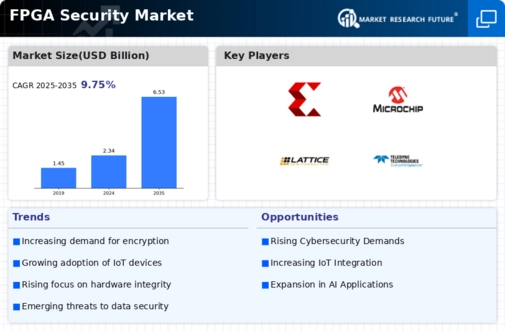Market Share
FPGA Security Market Share Analysis
The FPGA (Field-Programmable Gate Array) security market is experiencing significant growth due to the increasing adoption of FPGAs in critical applications such as aerospace, defense, telecommunications, and automotive, where security is paramount. FPGAs offer flexibility and customization, making them attractive for a wide range of applications; however, they also present security challenges such as intellectual property theft, data breaches, and tampering. In this competitive landscape, companies deploy various market share positioning strategies to differentiate themselves and gain a competitive edge.
One of the primary strategies employed by companies in the FPGA security market is product innovation. With the growing sophistication of cyber threats and the need for robust security solutions, companies invest heavily in research and development to enhance the security features of their FPGA products. This includes the integration of cryptographic algorithms, hardware-based security mechanisms, and secure boot functionalities to protect against unauthorized access, tampering, and reverse engineering. By offering comprehensive security solutions tailored to the unique requirements of FPGA-based systems, companies can differentiate their products and attract security-conscious customers.
Moreover, strategic partnerships and collaborations play a crucial role in market share positioning within the FPGA security market. Companies often form alliances with semiconductor manufacturers, system integrators, cybersecurity firms, and industry consortia to strengthen their product offerings and expand their market reach. Collaborative efforts enable companies to leverage partner expertise, access new distribution channels, and address emerging security challenges more effectively. By aligning with key stakeholders in the ecosystem, companies can enhance the interoperability, scalability, and trustworthiness of their FPGA security solutions, thereby gaining a competitive advantage.
Furthermore, effective marketing and branding strategies are essential for companies seeking to enhance their market share in the FPGA security market. Building a strong brand reputation and establishing thought leadership are critical for gaining customer trust and credibility. Companies invest in targeted marketing campaigns, industry conferences, and educational initiatives to raise awareness about FPGA security risks and showcase their expertise in addressing these challenges. By positioning themselves as trusted advisors and solution providers, companies can differentiate their offerings and capture the attention of potential customers.
In addition to product innovation and strategic partnerships, pricing strategies play a significant role in market share positioning within the FPGA security market. Price sensitivity is a key consideration for customers, particularly in industries with stringent cost constraints such as automotive and industrial automation. Companies adopt various pricing strategies such as value-based pricing, competitive pricing, and volume discounts to attract customers and gain market share. While maintaining profitability is important, companies may offer flexible pricing options and licensing models to accommodate different customer needs and budgetary constraints.
Moreover, a strong focus on customer support and service is essential for companies looking to enhance their market share in the FPGA security market. Providing timely technical assistance, comprehensive training programs, and responsive customer service can enhance customer satisfaction and loyalty. Companies that prioritize customer-centricity differentiate themselves from competitors and build long-term relationships with customers. By offering ongoing support throughout the product lifecycle, including software updates and security patches, companies can ensure the continued reliability and effectiveness of their FPGA security solutions.
Furthermore, geographical expansion and market diversification are key strategies employed by companies to increase their market share in the FPGA security market. By targeting new geographic regions and vertical industries, companies can tap into unexplored opportunities and reduce dependency on specific market segments. Expanding product portfolios to include specialized security solutions for emerging applications such as edge computing, IoT (Internet of Things), and AI (Artificial Intelligence) also enables companies to address evolving customer needs and capture a larger share of the market.







Leave a Comment